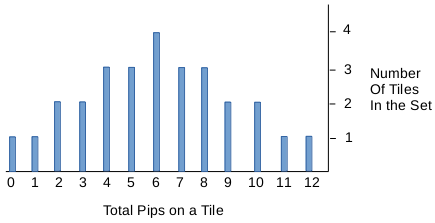Introduction to Dominoes
By Howard Fosdick © BestFreeNewGames.com
Dominoes are a set of generic playing pieces, just like playing cards. You can play an infinite variety of games with them. Select a game of sufficient strategic complexity and domino play becomes as challenging as that of any other game.
The 6-6 Set
A common dominoes set consists of 28 pieces. Its 6-6 tile is the piece with the highest total number of dots or pips on its face. Hence, the standard dominoes set is often called the 6-6 set. View its members above the red line in the illustration below. Each domino exhibits two numbers on its face. Look closely, and you'll notice
that these represent all possible combinations one could throw with two dice.
Each domino exhibits two numbers on its face. Look closely, and you'll notice
that these represent all possible combinations one could throw with two dice.Additionally, there is the blank. This represents the number 0 in many domino games. It similarly pairs with all possible combinations of the numbers 1 through 6.
21 of the 28 tiles in the 6-6 set are singlets. They show two different numbers on their face.
Seven of the bones repeat the same number twice. These are the doubles or doublets. The doublets in the 6-6 set are: 6-6, 5-5, 4-4, 3-3, 2-2, 1-1, and the 0-0 (or blank-blank). You can see the doubles ranging along the left-hand side of the diagram.
In standard-sized dominoes, the length of each tile is double its width. The backs should all be the same, indistinguishable from one another, much like the playing cards in any card deck. Also like playing cards, one can't play dominoes games with a set that is missing any tiles; all must be present.
The 9-9 Set
The larger 9-9 dominoes set includes all the tiles of the 6-6 set and adds 27 more, for a total of 55 pieces. These additional tiles are those that appear below the red line in the accompanying picture.The 9-9 set is a true superset of the 6-6 dominoes set. The tile with the greatest number of total pips on its face in the 9-9 set is, of course, the 9-9 domino. The 9-9 tile might be termed the "highest tile" or the "heaviest bone" in common parlance.
If you're not familiar with them, 9-9 sets are common and can be purchased at nearly any retail store that carries toys or games.
Especially when playing with the larger sets, we recommend dominoes with coloured pips because they make it easier to quickly identify tiles. Otherwise, as the bones clutter up with more dots, it requires some attention to distinguish one tile from another. Colour pips are a useful visual aid.
How to Create a Dominoes Layout
Many -- but certainly not all -- dominoes games require that participants play their pieces to a layout on the table. By a "layout", we mean simply a series of connected tiles.In your turn, you connect a tile to the existing layout by matching a number on your tile to a number on the layout.
In Example 1, the 1-5 domino was played first. It is referred to as the Set. In many games, players connect tiles in two directions off the set. Thus you have a single "line of play" that extends out from the set in two directions. Example 1 shows a contestant playing his 0-2 tile by connecting it to the existing layout.
 The playable ends of the layout are typically called open ends. In Example 1, the open ends are the 2-1 and 6-2 tiles.
After the player connects his 0-2 tile to the layout, the open ends will be on the 0-2 and 6-2 bones.
The playable ends of the layout are typically called open ends. In Example 1, the open ends are the 2-1 and 6-2 tiles.
After the player connects his 0-2 tile to the layout, the open ends will be on the 0-2 and 6-2 bones. In a bidirectional layout, it's common to place doublets at right angles to the line of play. Example 1 shows this with the 6-6 tile. This is merely a convention, it has no affect on the line of play.
Example 2 shows a game where the set is a spinner, a domino from which play may extend in four directions. Thus you have four open ends with tiles extending in each direction of the compass.
Domino layout games all have their own rules as to which dominoes are spinners (if any), and how the layout proceeds. But now you know the basic principle of play for most traditional dominoes layout games.

Playing Dominoes to Tricks
While many think of dominoes only in terms of large table layouts, in fact there exist many trick-taking tile games. In these, dominoes are played to tricks in much the same manner as playing cards in games such as Hearts or Bridge. Though little-known, these are some of the very best of domino games.
To fully cover this topic, we've written a complete article on the subject you can read here.
This website offers rules for the best of domino trick-taking games including 42, The Big Game, 11 Point Black Tile, and Domino Whist.
Pip Distribution in the 6-6 Set
The number of dots or "pips" in a 6-6 set totals 168. Understanding how the pips are distributed across the tiles can be useful in some dominoes games (for example, our own Scarnecchia). Here is how the pips are distributed across the tiles:
-----------------------------------
License: Feel free to print, copy, and distribute this webpage, so long as you retain this paragraph. Invented by Howard Fosdick © 2023, distributed under Creative Commons License BY-ND. HOME